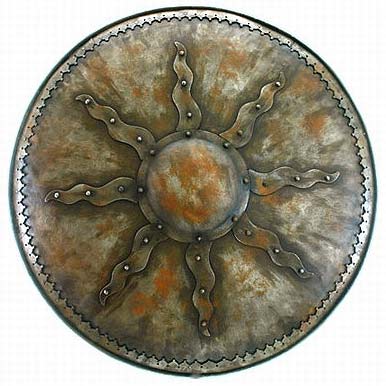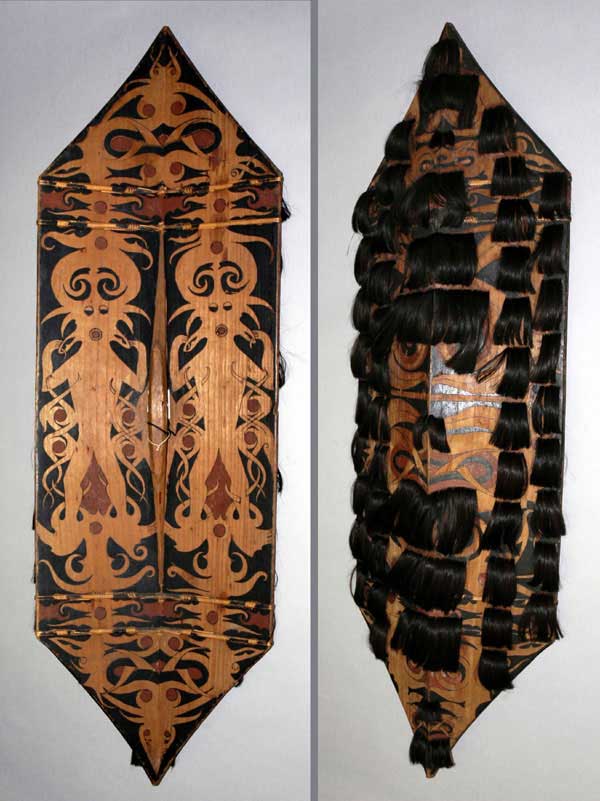Difference between revisions of "Shield (V7)"
| Line 43: | Line 43: | ||
===Things to note=== | ===Things to note=== | ||
''Magical and ablity effects that act on shields'' | ''Magical and ablity effects that act on shields'' | ||
| − | + | *[[Harden]] | |
| − | + | *[[Imbue Shield]] | |
| − | + | *[[Pyrotechnics]] | |
| − | + | *[[Warp Wood]] | |
| − | + | *[[Shield of Reflection]]; A relic, won at a Kingdom level [[Quest]]. | |
| − | |||
| − | |||
| − | |||
| − | |||
| − | |||
| − | A relic, won at a Kingdom level [[Quest]]. | ||
===Monsters=== | ===Monsters=== | ||
| − | Due to the very infrequent use of shields, | + | Due to the very infrequent use of shields, monsters denote if they can use them in their [[armor]] descriptions. |
| + | ===Links=== | ||
| + | Round saucer sleds make great shield core; here are some links. | ||
| + | *[http://outdoor-recreation.aubuchonhardware.com/games/snow_sleds/flying_saucer_disc-821128.asp Snow sleds] | ||
| + | *[http://www.sledwarehouse.com/plasticsleds.htm (under "flying saucer 3 pack")] | ||
| + | *[http://www.acehardware.com/product/index.jsp?productId=1287257&cp=&keywords=saucer&searchId=5354892081&parentPage=search hard ware] | ||
| + | =====brands===== | ||
| + | * pelican - good, lightweight, sturdy | ||
| + | * riva sports, space saucer, snowsled - good, heavy duty | ||
| + | Check out the [[Amtgard Resources]] page for more information. | ||
[[Category:Rulebook Terms]] | [[Category:Rulebook Terms]] | ||
Revision as of 18:16, 10 February 2009
Contents
A type of Equipment
A major component in the Tournament categories Sword and Board and Open.
From the Rulebook
Shields are considered wooden for purposes of being targeted by spells or monster abilities. All shield measurements are the exterior surface area on a flat plane. Bucklers are a type of small shield that is strapped to a forearm instead of wielded in a hand. Anyone allowed to use a small shield may use a single buckler. *Note: This does not allow use of both a shield and a buckler.* Shields struck by effects that break shields (such as Red weapons) retain this damage until repaired, therefore receiving two such strikes from one player and one such strike from another player ten minutes later is sufficient to destroy the shield. All shields must either be strapped to an arm or gripped in a hand. A blow that strikes a non-wielded shield strapped to a player, such as a shield slung across a back, is considered to strike the player as if the shield had not been there. A player may only wield one shield at a time. Non-round shields may not be wider than two feet.
- A large shield is no larger than eight square feet (38.3 inches in diameter).
- A medium shield is no larger than five square feet (30.28 inches in diameter).
- A small shield is no larger than three square feet (23.45 inches in diameter).
Legal Requirments for shields
For use when Reeveing or Judge

No metal or plastic parts can be exposed on the exterior face or on the outer edge of the shield. All rigid-core shields must either have foam folded over the edges or have the shield edges recessed into the foam. All rigid-core shields must be covered with a layer of foam that is at least 1 inch thick on the face, and 1 inch on the edge. Shields must be at least as safe as the weapons we use and cannot cause injury if used as intended.
Shields in history
The oldest form of shield was a protection used to block attacks by hand weapons, such as swords, axes and maces or missiles like spears and arrows. Shields have varied greatly in construction over time and place. Sometimes shields were made of metal, but wood or animal hide construction was much more common; wicker and even turtle shells have been used. Many surviving examples of metal shields are generally felt to be ceremonial rather than practical, for example the Yetholm-type shields of the Bronze Age or the Iron Age Battersea shield.

Size and weight varied greatly, lightly armored warriors relying on speed and surprise would generally carry light shields that were either small or thin. Heavy troops might be equipped with large heavy shields that could protect most of the body. Many had a strap called a guige that allowed it to be slung over the user's back when not in use or on horseback. During the 14th-13th Century, the Sards or Shardana, working as mercenaries for the Egyptian pharaoh Ramses II, utilized either large or small round shields against the Hittites. The Ancient Greek hoplites used a round, bowl-shaped wooden shield called an aspis. Examples of German wooden shields c350 BC - 500 AD survive from Weapons sacrifices in Danish bogs. Free standing shields called pavises were used by medieval crossbowmen who needed protection while reloading.
The heavily armored Roman legionaries carried large shields (scuta) that could provide far more protection, but made swift movement a little more difficult. The scutum originally had an oval shape, but gradually the curved tops and sides were cut to produce the familiar rectangular shape most commonly seen in the early Imperial legions. Famously, the Romans used their shields to create a tortoise-like formation called a testudo in which entire groups of soldiers would be enclosed in an armoured box to provide protection against missiles.
Many ancient shield designs featured incuts of one sort of another. This was done to accommodate the shaft of a spear, thus facilitating tactics requiring the soldiers to stand close together forming a wall of shields.
In the early European Middle Ages, kite shields were commonly used; these were rounded at the top and tapered at the bottom. They were easily used on horseback and allowed easier leg movement when dismounted. As personal body armour improved, knight's shields became smaller, leading to the familiar heater shield style. Both kite and heater style shields were made of several layers of laminated wood, with a gentle curve in cross section. The heater style inspired the shape of the symbolic heraldic shield that is still used today. Eventually, specialised shapes were developed such as the bouche — which had a lance rest cut into the upper corner of the lance side, to help guide it in combat or tournament.
In time, some armoured foot knights gave up shields entirely in favour of mobility and two-handed weapons. Other knights and common soldiers adopted the buckler (origin of the term "swashbuckler"[1]). The buckler is a small round shield, typically between 8 and 16 inches (20-40 centimeters) in diameter. The buckler was one of very few types of shield that were usually made of metal. Small and light, the buckler was easily carried by being hung from a belt; it gave little protection from missiles and was reserved for hand-to-hand combat. The buckler continued in use well into the 16th Century.
In Italy, the targa, parma and rotella were utilized by common people, fencers and even knights. The development of plate armour made shields less and less common as plate armour eliminated the need for a shield. Lightly armoured troops continued to use shields after men-at-arms and knights ceased to use them. Shields continued in use even after gunpowder powered weapons made them essentially obsolete on the battlefield. In the 18th Century, the Scottish clans used a small, round shield called a targe that was partially effective against the firearms of the time although it was arguably more often used against British infantry bayonets and cavalry swords in close-in fighting.
In the 19th Century, non-industrial cultures with little access to guns were still using shields. Zulu warriors carried large lightweight shields made from a single ox hide supported by a wooden spine, these were called Ishlangu. This was used in combination with a short spear (assegai) and/or club.
Shield Construction
Shields should be made from light, firm materials, should be well padded, and require a cloth cover. Hard edges may not be exposed. Good materials to use include substances with some give, such as plywood and high impact plastics. An interesting alternative is to use a plastic snow toboggan, which will produce a light shield that requires less padding. Another popular shield design uses only a thick foam disc, thus negating the need for additional padding (just a cloth cover). Be careful with these however, as not all foam materials are the same. Plank foam is a particularly durable and safe variety that makes for an excellent shield; while foam such as what ‘boogie boards’ are made of is effectively a rigid material and requires padding. Thick strips of leather make good arm straps. When using a non-foam shield, bolts should be attached with the head affixed to the exterior of the shield with washers, and then heavily padded with foam.
Things to note
Magical and ablity effects that act on shields
- Harden
- Imbue Shield
- Pyrotechnics
- Warp Wood
- Shield of Reflection; A relic, won at a Kingdom level Quest.
Monsters
Due to the very infrequent use of shields, monsters denote if they can use them in their armor descriptions.
Links
Round saucer sleds make great shield core; here are some links.
brands
- pelican - good, lightweight, sturdy
- riva sports, space saucer, snowsled - good, heavy duty
Check out the Amtgard Resources page for more information.